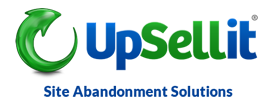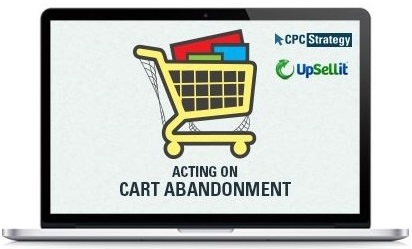Actionable Tips for Reducing Site Abandonment

This is a guest post by Bryan Gudmundson, Creative & Marketing Director at UpSellit. Hear from UpSellit when they team up with us on March 13th for our webinar: Acting on Abandonment.
 Website abandonment is a fact of life for online retailers. On average, only about 3.3% of visitors convert on a typical e-commerce website. This means that 96.7% of visitors are abandoning at some point in the customer journey–but where? And what can you do to keep them on the path to conversion?
Website abandonment is a fact of life for online retailers. On average, only about 3.3% of visitors convert on a typical e-commerce website. This means that 96.7% of visitors are abandoning at some point in the customer journey–but where? And what can you do to keep them on the path to conversion?
Today, we’re going to walk through the different types of website abandonment and provide some easy tips on what you can do to make a more complete, efficient conversion funnel. There are five different types of abandonment, each of which refers to a user leaving the site from a specific stage of the conversion funnel:
 Let’s take a look at each type of abandonment and talk about what you can do to lower rates.
Let’s take a look at each type of abandonment and talk about what you can do to lower rates.
Due to it’s all-encompassing nature, website abandonment is reduced by making changes to site-wide elements. From design to navigational tools to brand imagery and identity, any component that permeates a website entirely can contribute to website abandonment. However, just because people are abandoning your website doesn’t mean that your entire layout needs to be redesigned. Keep in mind the following tips to try and keep people engaged and shopping across all pages:
Mobile Optimization – Nearly every study released in the last few years agrees about one thing: the rise of the mobile web is happening here and now. With each passing day, more people are putting down the mouse and keyboard and picking up a smartphone to do their browsing (and shopping) on the go. In order to promote smartphone shopping, you’re going to want to pay attention to a few key elements.
Speak Their Language – According to Common Sense Advisory, 52.4% of people will complete a purchase only if product information is available in their language. Take a look at the primary sources of your traffic and make sure that content is available in the native languages of your most popular countries. Use location detection tools to determine which language to display by default for each visitor.
Among e-commerce websites, the average bounce rate rests at around 36.5%. This means that approximately one third of visitors will abandon without any browsing or clicking. Reducing bounce rates is about making a user’s very first experience with your site pleasing, intuitive, and in line with their expectations. The following tips will help make the first few moments on your page more captivating.
Reduce Load Times – People have little patience for load times. According to a study from Akamai, 40% of users will not wait longer than three seconds for a page to materialize. Don’t leave your users staring at a stark white browser window; try the following:
Repair Broken and Outdated Links – It may seem elementary, but leaving up dead URLs and linking to old pages is more common than you might think. In order to keep users from starting at a dead-end:
Product pages are the digital salesmen of your online store. These pages give customers a chance to evaluate a product and determine whether they trust your company enough to give you their business. The following tips will help your keep customers from deciding to shop elsewhere.
Page Layout – People who go online to make purchases have come to expect a certain order to things–prominently displayed photography, ample product descriptions, unmistakably clear call-to-action buttons. On product pages, it’s best to stick to a familiar format and keep it consistent to make sure customers feel comfortable.
Photo/Video Quality – Photos and videos are the only tools a user gets to look at an item before they take the plunge and purchase. Users never get the chance to actually touch what they’re about to buy, so the imagery provided needs to be a powerful enough supplement.
Shopping cart abandonment is the single most discussed type of abandonment–and for good reason: 70% of filled shopping carts are abandoned. Unfortunately, it’s also the most commonly misdiagnosed type of abandonment. Cart abandonment refers specifically to when items are placed in the cart and the user exits the website without proceeding to checkout. The shopping cart is the last stop before checkout; this is where it’s most important to reassure users and move them quickly through to checkout. Alleviate hesitant consumers with the following tips:
Shipping Fee Clarity – An unexpectedly large shipping fee is the number one reason for shopping cart abandonment. Some companies believe that by withholding shipping prices until later into checkout, they’ll be able to convince customers to purchase despite large fees. This is entirely false. It is always best to be upfront with your customer regarding shipping, return, and taxation policies in order to maximize conversion rates and lifetime value.
Offer Support – Before making the final step into the payment phase, it’s not unlikely that a customer will have a question. If they reach out for help and find nothing to grasp, they’ll be more likely to abandon. Somewhere in the cart interface, display any email addresses, a phone number, or a click-to-chat that customers can use for assistance.
Of all visitors to a website, an average of 4.8% of users make it to checkout. Only 56.3% of this small subset completes their purchase–the other 43.7% either run into an error or decide against making a purchase at the last minute.
A Direct Path to Confirmation – Ambiguity has a tendency to make people uncomfortable, particularly when money is part of the equation. As users move through checkout forms and input their billing information, you’ll want to do your best to make sure the process is as simple as possible.
Easy Input – In addition to making users comfortable with a simple checkout, you’ll want to make the process as brief as possible. Not only is this a convenience for your customers, it also limits the amount of time a potential client has to decide against a buy. Here are a few ways to keep things quick:
 While there are plenty of steps you can take to reduce website abandonment at every stage, these actionable tips should make a significant difference in abandonment rates. However, even the most optimized websites still suffer from high abandonment rates. For the last eight years, UpSellit has developed completely customized solutions for a wide range of online businesses. With a suite of proprietary technologies, a wealth of business intelligence and proven strategies, UpSellit develops 100% pay-for-performance site abandonment solutions.
While there are plenty of steps you can take to reduce website abandonment at every stage, these actionable tips should make a significant difference in abandonment rates. However, even the most optimized websites still suffer from high abandonment rates. For the last eight years, UpSellit has developed completely customized solutions for a wide range of online businesses. With a suite of proprietary technologies, a wealth of business intelligence and proven strategies, UpSellit develops 100% pay-for-performance site abandonment solutions.
To learn more about the different types of abandonment and what you can do to reduce abandonment on your site, be sure to sign up for the upcoming webinar with UpSellit. UpSellit provides a full suite of abandonment solutions, designed and custom configured to reduce abandonment at every stage of the conversion funnel. For more information or to see our solutions in action, schedule a demonstration with our team today.
